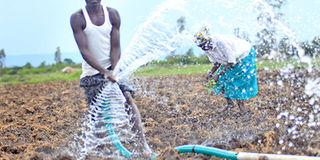A guide to rotating crops on your farm

A farmer waters his farm in Ahero, Kisumu County. Agriculture practices like crop rotation improves soil structure. FILE PHOTO | NMG
What you need to know:
- Crop rotation helps one control build-up of soil-borne pests and diseases. Some pests and diseases are specific to various crops.
- Crop rotation will improve soil structure. At the end of the rotation programme, grass should be planted on the land.
- During this time when grass is growing, there is little disturbance of the soil and the roots of grass are extensive such that they bind the soil particles together thus improving soil structure.
- This will ensure that the spaces which were left when the row crop was grown are protected from soil erosion when the cover crop is grown.
Crop rotation is the practice of growing various crops or crops that belong to different families on the same piece of land in an orderly sequence.
One achieves this by dividing land into plots and then grows different crops on the sections in a particular season. Then in the next season, the crops are rotated or grown on different plots.
Crop rotation is only possible in annual crops, which are those that take a year or less to mature.
Importance of crop rotation
Crop rotation ensures maximum utilisation of nutrients. You see, different crops have different nutrient requirements in terms of the type and the depth of absorption.
Maize absorbs a lot of nitrogen from the soil and little potassium.
On the other hand, cassava absorbs a lot of potassium and very little nitrogen from the soil. Therefore, carrying out rotation of maize and cassava will ensure maximum use of nitrogen and potassium.
In terms of the depth of absorption, deep-rooted crops absorb nutrients from the deep layers of the soil compared to shallow-rooted crops, which absorb nutrients from just below the soil surface. Alternating such crops will ensure that nutrients from different layers are well-utilised
Crop rotation helps one control build-up of soil-borne pests and diseases. Some pests and diseases are specific to various crops.
These pests and diseases will attack crops of the same family when grown in succession. To control these pests and diseases, such crops should be alternated with others from different families.
Crop rotation helps to control weeds. Some weeds are specific to certain crops. A good example is witchweed (Striga spp), which attacks crops of the Poaceae family. This weed can be controlled by planting crops from other families for a period of time.
Crop rotation leads to improvement of soil fertility if legumes are included in the rotation. Leguminous crops (Fabaceae family) improve soil fertility through nitrogen fixation with the help of rhizobia bacteria, which are found in their root nodules. The nitrogen is used by subsequent crops in the rotation programme.

Common crops for crop rotation and the families they belong to. ILLUSTRATION | COURTESY
Crop rotation will improve soil structure. At the end of the rotation programme, grass should be planted on the land.
During this time when grass is growing, there is little disturbance of the soil and the roots of grass are extensive such that they bind the soil particles together thus improving soil structure.
Crop rotation can also help to control soil erosion. Crops planted in rows like maize should be rotated with cover crops like sweet potatoes.
This will ensure that the spaces which were left when the row crop was grown are protected from soil erosion when the cover crop is grown.
It is important to know that:
Deep-rooted crops should be alternated with shallow-rooted crops.
Heavy feeders (crops that require a lot of nutrients) should be the first ones to be grown in a newly opened land.
Crops associated with certain weeds should be rotated with those that are not.
Crops which are easy to weed should be rotated with those that are not easy to weed.
Crops which belong to the same family should not follow each other in a rotation programme because they are attacked by the same pests and diseases.
Leguminous crops should be included in a rotation programme to improve soil fertility
A grass ley should be established at the end of the rotation programme
Check whether the selected crop for planting will grow during the season of the year for which it’s scheduled during planning.
The writer works in the Department of Crops, Horticulture and Soils, Egerton University




